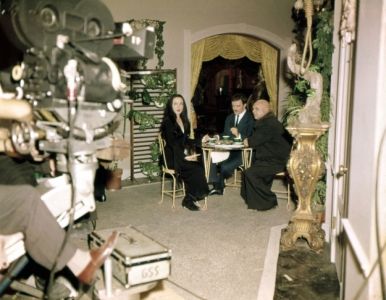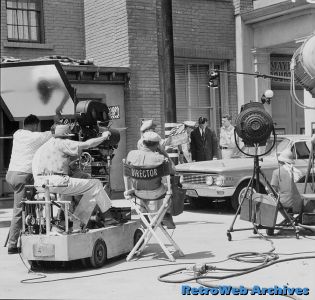Difference between revisions of "Editing: Single Camera Mode (Discussion)"
From Screenpedia
Jump to navigationJump to search| Line 1: | Line 1: | ||
| − | ==Single-Camera | + | ==Single-Camera productions: Behind the scenes== |
<gallery mode="packed" heights=200px> | <gallery mode="packed" heights=200px> | ||
File:Addams Family Still.jpg|alt=The Addams Family, circa 1960.|''The Addams Family'', circa 1965 | File:Addams Family Still.jpg|alt=The Addams Family, circa 1960.|''The Addams Family'', circa 1965 | ||
File:Andy Griffith Show street scene.jpg|alt=Promotional photograph, The Andy Griffith Show. From the episode, "Barney's Replacement," broadcast October 9, 1961.|''The Andy Griffith Show'', 10/6/1961 episode | File:Andy Griffith Show street scene.jpg|alt=Promotional photograph, The Andy Griffith Show. From the episode, "Barney's Replacement," broadcast October 9, 1961.|''The Andy Griffith Show'', 10/6/1961 episode | ||
</gallery> | </gallery> | ||
| + | |||
| + | |||
'''Key terms''' | '''Key terms''' | ||
| Line 35: | Line 37: | ||
'''Decoupage exercise: #2''' | '''Decoupage exercise: #2''' | ||
| − | If you finish early, do a similar analysis of | + | If you finish early, do a similar analysis of a scene from ''Scrubs'' or a scene from ''The Sopranos'' (on Blackboard). Draw another diagram and work through the questions above. |
== Bibliography == | == Bibliography == | ||
| Line 46: | Line 48: | ||
#[https://tvcrit.org/Classes/Jbutler/T112/classicism/index.php#editing Classical Editing Examples] | #[https://tvcrit.org/Classes/Jbutler/T112/classicism/index.php#editing Classical Editing Examples] | ||
| + | [[Category:BUI301]] | ||
| + | [[Category:BUI301 Discussion]] | ||
[[Category:JCM311]] | [[Category:JCM311]] | ||
[[Category:JCM311 Discussion]] | [[Category:JCM311 Discussion]] | ||
Revision as of 19:37, 28 September 2020
Single-Camera productions: Behind the scenes
Key terms
- Establishing shot
- Re-establishing shot
- The shot-counter shot editing pattern (also known as "shot-reverse shot")
- Match cut
- Match-on-action
- Eyeline match
- Jump cut
- 180° rule (see Peter John Ross example)
- Screen direction
- How/when might this rule be broken in a TV program?
Decoupage exercise: #1
- Do a sample decoupage--as explained with a Grey's Anatomy scene--of shots 33-44 from this Chevrolet commercial.
- Each student should start by drawing an overhead view similar to Figure 10.24.
- Each student should be prepared to answer the following decoupage questions from the textbook (p. 272), although you may talk about them in your group:
- How is the scene’s space, the area in which the action takes place (i.e., the car), introduced to the viewer? Does an establishing shot occur at the start of the scene (or later in it)?
- Skip.
- Do these angles adhere to the 180° rule? Can you draw an axis of action? Is screen direction maintained? If not, why is the viewer not disoriented? Or if the space is ambiguous, what narrative purpose does that serve?
- Skip.
- Is an alternating editing pattern used? Is shot-reverse shot used?
- How does the camera relate to the character’s perspective? Are there point-of-view or subjective shots? If so, how are those shots cued or marked? That is, what tells us that they are subjective or point-of-view shots?
- Is match-on-action used? Are there jump cuts?
- How does the last shot of the scene bring it to a conclusion?
- Skip.
Decoupage exercise: #2
If you finish early, do a similar analysis of a scene from Scrubs or a scene from The Sopranos (on Blackboard). Draw another diagram and work through the questions above.
Bibliography
- Butler, Jeremy G. Television: Visual Storytelling and Screen Culture. New York: Routledge, 2018.

